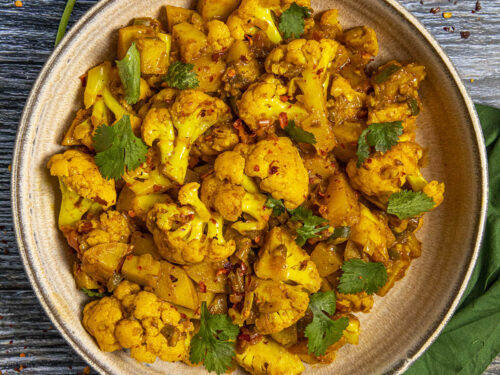Aloo Gobi: A Culinary Tapestry Weaving Tradition, Flavor, and Nourishment

Introduction: In the vast mosaic of Indian cuisine, there exists a dish that epitomizes simplicity, yet bursts with flavor and warmth – Aloo Gobi. This humble yet delectable concoction of potatoes (aloo) and cauliflower (gobi), simmered in a fragrant blend of spices, holds a cherished place in the hearts and kitchens of households across India. Join us on a journey as we uncover the origins, cultural significance, and intricate recipe of Aloo Gobi, a dish that embodies the essence of home-cooked comfort and culinary heritage.
Origins and Cultural Significance: Aloo Gobi traces its roots deep into the culinary heritage of the Indian subcontinent, with its origins shrouded in the rich traditions of regional Indian cooking. The dish is believed to have originated in the northern states of India, particularly Punjab, where potatoes and cauliflower are abundant and form essential ingredients in the local diet.
The name “Aloo Gobi” itself reflects the simplicity and authenticity of the dish, with “aloo” meaning potatoes and “gobi” referring to cauliflower in Hindi. Traditionally, Aloo Gobi was a staple in Punjabi households, where it served as a wholesome and nourishing meal for families, especially during the winter months when fresh vegetables were readily available.
Beyond its culinary appeal, Aloo Gobi holds cultural significance as a symbol of home-cooked comfort and familial warmth. It is often prepared with love and care by mothers and grandmothers, passed down through generations as a cherished family recipe, creating a sense of connection and continuity across the dining table.
Recipe and Preparation: The preparation of Aloo Gobi is a testament to the artistry of Indian home cooking, requiring simple ingredients, subtle spices, and a gentle touch to coax out the flavors of the potatoes and cauliflower. While variations of the recipe abound, each with its unique twist, we present a traditional Aloo Gobi recipe that captures the essence of this beloved dish.
Ingredients:
- Potatoes (Aloo): 4 medium-sized, peeled and cubed
- Cauliflower (Gobi): 1 medium-sized head, cut into florets
- Onion: 1 large, finely chopped
- Tomato: 2 medium-sized, finely chopped
- Ginger: 1-inch piece, grated
- Garlic: 4-5 cloves, minced
- Green chilies: 2-3, slit lengthwise
- Cumin seeds: 1 teaspoon
- Turmeric powder: 1/2 teaspoon
- Coriander powder: 1 tablespoon
- Cumin powder: 1 teaspoon
- Red chili powder: 1 teaspoon
- Garam masala powder: 1 teaspoon
- Salt: to taste
- Cooking oil or ghee: 3 tablespoons
- Fresh coriander leaves: for garnish
Instructions:
- Heat oil or ghee in a large skillet or pan over medium heat. Add cumin seeds and let them splutter.
- Add chopped onions to the pan and sauté until they turn golden brown.
- Add minced garlic, grated ginger, and slit green chilies to the pan. Sauté for a few minutes until aromatic.
- Add chopped tomatoes to the pan and cook until they turn soft and mushy.
- Add turmeric powder, coriander powder, cumin powder, red chili powder, and salt to the pan. Mix well to combine the spices with the onion-tomato mixture.
- Add cubed potatoes and cauliflower florets to the pan. Mix gently until the vegetables are coated with the spice mixture.
- Cover the pan and cook the vegetables on low heat, stirring occasionally, until they are tender but not mushy. This may take around 15-20 minutes.
- Once the vegetables are cooked, sprinkle garam masala powder over the Aloo Gobi and mix well.
- Garnish with freshly chopped coriander leaves before serving.
Conclusion: In conclusion, Aloo Gobi is more than just a dish; it’s a celebration of simplicity, flavor, and tradition in Indian cuisine. From its humble origins in the kitchens of Punjab to its widespread popularity as a beloved vegetarian delicacy, Aloo Gobi embodies the essence of home-cooked comfort and familial warmth. So, the next time you savor a spoonful of this flavorful concoction, cherish not just the taste but also the centuries of culinary heritage and cultural richness that have shaped its legacy.




